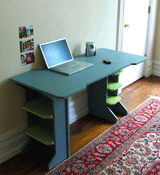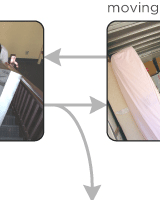
A furniture series designed to address moving issues encountered in a city environment.
Space is the primary concern since most halls and entrances are narrow while furniture pieces are often large and cumbersome. Thus the goal of the Urban Nomad project is to develop furniture that suits an urban nomadic life style.









Urban nomadism exists and is a product of the modern transportation network. It is most prevalent among young adults who have not settled down. The majority move within a given city/area for reasons such as shifting priorities (neighborhood, distance from work or friends, etc) and changing living conditions (room-mate or neighbor issues, rent fluctuation, etc).
Development / Ideation
Given the functionalist nature of this project, the primary objective was to develop a modular system that makes moving smooth and easy.
The pieces must be light enough to carry by hand, small enough to fit through stairwells, and sturdy enough to survive a bumpy ride. ideally it should be easy to assemble and disassemble.
Prototypes
The first model was a bed frame that held itself together with halved joints. Legs were screwed onto the end piece of each frame. The frame was sturdy enough to function for several years.
Model #2 was a desk with integrated shelving. The design omitted screws in favor of finger joints. Shelves were designed with a concave front to facilitate easier access to bottom shelves.
Revision
Both models lacked sufficient bracing to prevent lateral wracking. Therefore, both were prone to leaning or shifting from side to side.
Finger joints were difficult to fit because router pocketing can only create rounded inside corners.
3/4" plywood had noticable warp over long distances and was thus an unsuitable material for construction or table surfaces.
Final
The final model was redesigned with extra bracing and used fibreboard. Finger joints were removed in favor of slats to ease assembly and openings were cut in back to provide space for cables to pass through. In addition, two different bookshelves were designed. Each can be slotted to either side of the desk and face 4 different directions. All in all, the design provides a sturdy solid table that is moderately configurable and very easy to disassemble and move.



























